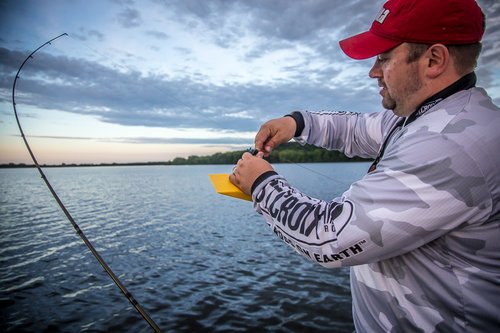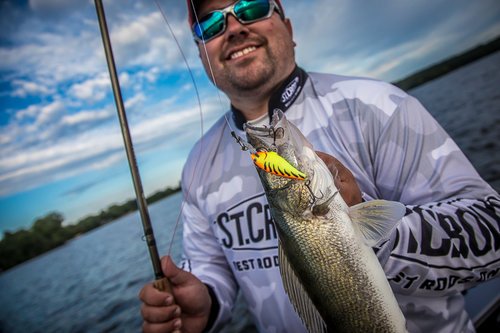I was at a friend’s cabin near Hackensack, MN last winter when my cell phone rang. It was Al Lindner, and Al’s excitement was infectious. We both talked at length about an idea that’s probably the number one question I get no matter what I do in the fishing industry. Whether at a seminar, retail event, or via email, people are fascinated by the question, “How Do I Make a Living in the Fishing Industry?”
Al invited me as one of many in a panel of speakers for a workshop held this fall, which is designed to help answer just that question. That’s because there’s more than one path to help turn your hobby into a livelihood. There’s all kinds of roles throughout “fishing,” from marketing specialists, product developers, writers, media personalities, biologists, conservation officers, and many, many more. Each person’s journey is different, and depending on your skill set, you may be well-suited for several roles but not for others. While no two paths are the same, here are some nuggets of wisdom that have been shared with me, which I’ve found to be especially true no matter which direction you tread down.
My start actually came while I was already involved headlong in another natural-resources related career. I began in the late 1990’s posting on various online fishing forums, sharing advice and being helpful when I could as others had questions. When I had fishing information to share, I relayed simply those bits that as an angler I would want or be interested in myself. It wasn’t long before that online writing began to catch the attention of some manufacturers, who in the early years I partnered with because I’d always used their products and believed in them.
I was young and impetuous, quick-witted but slow-minded. I made every mistake in the book but maintained my passion for the outdoors through it all, constantly striving to both whet my appetite for hunting and fishing goals I already had of myself, while trying to partner with companies to help fund my addiction. Call it trial-by-fire or more appropriately, trial-and-error, I mucked my way through the initial years. I spent the first five of it not really getting paid for any of the writing, online promotional work, or retail events I did, and the next ten doing my best to perform tasks as a business; professionally delivering services while not going backwards financially in the process.
As for writing, Outdoor News Columnist and legendary writer Gary Clancy was famous for saying, "The most important requirement of being an outdoors writer is having a wife with a good job." I’d tend to agree with his statements as I’ve pushed for nearly two decades to simply earn a seat at the table. Which is why money needs to be a motivating factor but not a primary goal in this line of work.
The fishing industry most certainly isn’t for everyone. However, if you were the “fishiest” kid among your group of friends or in your whole school, this may be for you. If all four seasons of the year’s calendar revolved around the next trip, fishing-season, or timely outdoors activity, you may be able to withstand the long hours and sacrifices. More importantly, if you find yourself already taking existing skills like writing, photography, speaking, sales, and marketing to bear for fishing-related purposes, this just may be your calling.
Let’s get one thing straight however. Being a skilled angler is not enough, for most jobs in the industry it’s simply a prerequisite. Very few people get paid to fish, and those that do are either at the pinnacle of their careers or more often are doing so under the pressure of a budget, schedule, or other constraining factors which for most people, makes it no longer resemble the fishing they once knew and loved.
If you’re a freelancer, you must make the initial capital investment in yourself, with the hopes of eventually growing your thought-leadership such that your voice may be heard. That capital investment for me was a strong education, and I recommend it to all anglers hoping to someday work in fishing. Do this while understanding that your expectations should equal your effort, noting that most start-ups no matter the industry don’t turn a profit for the first few years. Your “business” whatever it may be, will in the early years be funded 95% by you, and 5% by the industry. Your “business plan” should be to reverse those numbers over a period of time. During this time it’s common to have a side job or two in order to pay the bills.
Decide what to be, and go be it. Specialize early on to bring your talents to bear for underserved disciplines, locations, or species. Know your strengths, but more importantly, your limitations, while building relationships with the companies, brands, andtheir representatives. Don’t ask for a thing from them until you have forged a strong relationship, and they know you as someone that may be able to help them. Build your voice through as many avenues as you can, whether it be online, print media, in-person, or all of the above. All the while, live a clean life, as it’s worth saying that one mistake can destroy credibility, which you should value above all else.
As Al and I wrapped up our conversation that winter’s day, I couldn’t help but look out over the frozen lake while thinking on all the mistakes, mis-steps, and lost opportunities I had squandered mostly on account of not knowing any better. If you’re serious about a career in the industry, you owe it to yourself to bone-up on the subject far better than I ever did. There’s some great books out there, online advice, and this Fishing Career’s workshop coming up. Whether you decide that it’s for you, or it’s not, I know I’m incredibly thankful for the wisdom passed on-to me, and I’m hoping to pay-it-forward as best I can this October.
Al and Troy Lindner are hosting the “Fishing Career’s Workshop,” on Saturday October 27th, at Cragun’s Resort in Brainerd, MN. Go to https://mycampfish.com/products/fishing-careers-workshop to sign-up. Limited seats available.





